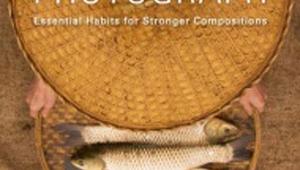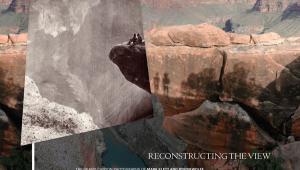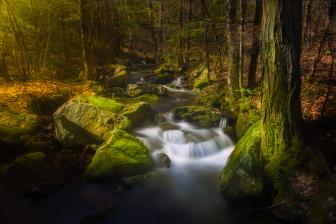Our Beautiful, Fragile World: The Nature And Environmental Photographs Of Peter Essick

Our Beautiful, Fragile World: The Nature and Environmental Photographs of Peter Essick (hardcover, 124 pages, Rocky Nook, ISBN: 978-1-937538-34-7) features a career-spanning look at the images of photojournalist Peter Essick taken while on assignment for National Geographic magazine. In this book, Essick showcases a diverse series of photographs from some of the most beautiful natural areas in the world and documents major contemporary environmental issues, such as climate change and nuclear waste.
Each photograph is accompanied by commentary on the design process of the image, Essick’s personal photographic experiences, and informative highlights from the research he completed for each story. Our Beautiful, Fragile World takes the reader on a journey around the globe, from the Oulanka National Park near the Arctic Circle in Finland to the Adelie penguin breeding grounds in Antarctica.
Our Beautiful, Fragile World will interest photographers of all skill levels. It carries an important message about conservation, and the photographs provide a compelling look at our environment that will resonate with people of all ages who care about the state of the natural world.— Liner notes supplied by publisher.
Though photography has often been allied with a consciousness about the environment and the need to protect and preserve it, photographers today have more access and ability to cover greater swaths of our planet, thus often develop a world consciousness about crucial issues affecting climate, the perils of pollution and preservation of the planet. Peter Essick’s images and words are worthy of study and enjoyment; they combine a keen visual sense of the beauty of our planet and how he, as a world-class photographer, captures it, along with observations about what’s at stake for this and future generations should we turn away from our responsibilities as stewards of the land and air.—Editor
Dangerous Work: A Close Call in Tracy Arm, Alaska

It was 17 degrees F on the day in March that I hired a floatplane to take me from Juneau, Alaska, to the Tracy Arm Wilderness. A few days before, I had flown over the tidewater glacier and had seen some beautiful icebergs floating in the seawater. I wanted to photograph the icebergs up close and get the glacier in the background.
After talking to the pilot, I learned that a floatplane couldn’t safely land near the glacier because of the many icebergs. The closest place the plane could land was about a mile down the fiord. I decided to be flown in near the glacier, and then to put on a cold weather dry suit, pump up a small inflatable boat, and paddle up close to the glacier. I went to a dive shop in Juneau (yes, some people do dive in Alaska) and was able to convince a dive master to go with me the next day.
The following day we flew to Tracy Arm and landed on the seawater. I was pumping up the boat when I noticed the plane starting to tilt—the float on the plane was filling up with water. The pilot yelled for us to throw everything back in the plane so we could try to take off, but the water in the float was already too heavy. Eventually, the plane started to sink about 100 feet from the bank of the fiord. The pilot said we would have to swim to shore, and I spotted a small snow bank, the only somewhat-level place where we could climb out of the water.
I had to make a quick decision of what to take with me. Should I take food and survival equipment, or save the thousands of dollars of camera equipment that was in the back of the plane? I took a small bag with one camera and lens and tried to throw it to shore. It landed short, in the water, but I was happy when I learned that the case both floated and kept my equipment dry. The pilot threw a knife towards the shore and it landed in the snow bank. Then the pilot, the dive master, and I all jumped in and swam for shore in the freezing water.
We were dangerously cold from being soaked, but as it turned out, the knife had a lighter in the handle. We were able to use the lighter to make a fire and warm our freezing fingers and toes. About eight hours later, another plane from the same Juneau flight service came and rescued us. The next day we went back with a barge and salvaged the plane, though it was considered a total loss after being submerged for a day in the salt water. The following day, I flew back to the glacier and took the picture I had originally envisioned.
I am often asked if the work I do for National Geographic is dangerous. I always answer that I don’t cover wars or go to combat zones working on feature articles. Statistically, the most dangerous part of my job is driving in cars in various countries in unfamiliar settings. However, when I think back to my experience in Tracy Arm, I realize I was in a truly dangerous survival situation. It turned out the pilot had made a huge error in forgetting the drain plug of the plane’s float, but he probably saved the three of us by realizing the importance of that lighter in the handle of his knife.
The photo was published in 1998 in an article on the American Wilderness System.
Butte, Montana: Long After the Boom Went Bust

One afternoon in Butte, Montana, I saw a young boy looking out a window against a backdrop of old mines and dilapidated homes. It seemed to illustrate quite a bit of symbolism regarding the history of hard rock mining, so I took a few frames and continued walking.
The more I thought about it, the more I realized that Butte was a good example of why we need economies built around sustainable development. We tend to think of environmental stories as depictions of pollution of the water, land, and sky. Certainly Butte has plenty of all three. In the region around Butte, there are scores of abandoned mines with toxic tailings that cause particulate air pollution, and there is a mined-out, open pit that is now filled with polluted groundwater.
However, there is also the story of how dependence on a non-renewable resource causes a boom and bust economy that can be harmful to the community that depends on it for employment. From the late 19th century until the present, Butte has gone through all the cycles associated with an economy based on mining. Butte started as a mining camp and grew into a boomtown that, in 1920, had a population of 60,000, making it one of the largest towns west of the Mississippi. The mines were right in the town, and Butte’s nickname was “the richest hill on Earth.” The town was known for its rough-and-tumble individualism. There was a large saloon and a red light district. The famous Dumas Brothel operated legally in Butte from 1890 to 1982.
In the 1950s, Anaconda Copper switched from underground mining and started excavation of the Berkeley Pit. Thousands of homes were destroyed in order to dig the huge, open pit copper mine, which was the largest of its kind in the United States at the time. When operations in the pit and surrounding mines were shut down in 1982, the water pumps that had been keeping out the groundwater were also turned off. The pit filled with groundwater that was highly acidic and laced with heavy metals, making it toxic to humans and migratory birds. In one incident, 342 migrating geese died when they landed in the lake. This resulted in loudspeakers being installed to scare off wildlife.
Eventually, the town’s economy switched to historic preservation and environmental cleanup. With miles of contaminated waterways nearby, along with four open pits, the Silver Bow Creek/Butte Area Superfund Site is one of the largest in the United States. The third five-year review report was signed in 2011, and the list of remediation procedures is mind boggling. The work has included soil stabilization and removal of thousands of cubic yards of contaminated soil, construction of many treatment ponds, and expensive biological monitoring.
In an ironic twist, the Berkeley Pit is now one of the most popular tourist attractions in Butte. For a $2 admission to the viewing platform, one can see the one-mile-long, 1,780-foot-deep pit filled with heavily acidic (2.5pH) water thatis 900 feet deep. There is also a gift shop nearby.
My best motivation to do environmental stories is when I see children like the boy looking out the window in Butte and wonder about the world we are leaving for them.
Fraser Island: Pure Dingoes and Dunes

At 72 miles long, Fraser Island, off the coast of Queensland, Australia, has the distinction of being the largest sand island in the world. For the last 750,000 years, ocean currents from the southeast have been washing sand ashore, where it collects on volcanic bedrock.
The island is a phenomenal place for a landscape photographer. There are sand dunes, of course, but there are also rainforests, eucalyptus woodlands, mangrove forests, wallum, peat swamps, and coastal heaths. If you have a special four-wheel drive vehicle with sand tires, everything is pretty accessible as long as you learn how to drive on the beach at low tide and avoid getting your vehicle stuck in deep sand.
Sand dunes are always a good photographic subject, and Fraser Island has many varieties. Along the eastern coastline are foredunes that are 100 to 200 feet high. They are vegetated with beach spinifex and pandanus trees. On the island’s interior, the high dune ridges are between 300 to 700 feet high, and white sand mixes with darker, coffee-colored sand. There are 50 strikingly beautiful freshwater lakes in this part of the island.
The oldest deposits of sand, which have a brighter orange color, are along the western coast.
I worked with photographer Peter Meyer on the assignment. Peter works as a guide for the Kingfisher Resort, but has also spent many years photographing on the island. He showed me all his favorite spots. One morning, we were out photographing on the Tukkee Sand Blow. A sand blow is formed when heavy winds blow sand not stabilized by vegetation across the island. These mobile sand dunes often overtake and bury large trees and other plants. Then, pioneer plants move in and colonize the dunes, and the sand becomes vegetated again. The whole cycle can take one thousand years or more.
The sunrise lighting on the sand blow wasn’t too good, but we happened to spot a dingo out on the dunes, which Peter said was a rare sight. The dingo was walking into a strong headwind, looking and smelling for bits of vegetation that might blow his way, and it didn’t pay much attention to me.
No one knows for sure, but it is hypothesized that dingoes came to Australia about 4,000 years ago with seafarers from Southeast Asia. Recent DNA evidence supports this theory. A dingo is not classified as a wolf or a dog—it is somewhere in between the two—but there has been a lot of recent cross breeding with Australian dogs. The dingoes on Fraser Island are said to be the most pure in Australia, and in an effort to preserve their purity, no dogs are allowed on the island. In 2001, a young boy wandered away from his family’s campsite on the island and sadly, was found dead, presumably mauled by a dingo. This led park rangers to kill over 120 dingoes as a reaction to the incident. By 2009, it was estimated there were only 100 to 120 dingoes left on Fraser Island, and their numbers are still decreasing.
Finnish Moonlight: Sometimes It All Works Out

For a story on the Oulanka National Park in Finland, I arranged three two-week trips. The first was in early summer, timed for the best hiking season, the midnight sun on June 21, and the wildflowers. The second trip was in fall for the autumn colors. The last trip was timed for two weeks in February, when there is usually still snow on the ground, but there are more daylight hours than in December or January. That two-week period also was chosen to include the full moon.
Located in the Boreal forest, Oulanka features pine, spruce, and birch trees. The spruce trees are at a low elevation and get lots of water, so they grow very tall. The local people call them candle spruce. I was told that if the temperature reached minus 20 degrees C that the falling snow would cling to the trees. In my head I dreamed up a picture of a forest of candle spruce trees lit by moonlight with the northern lights glowing in the background.
When I arrived, the temperatures had been warmer than normal (climate change?) and there was no snow clinging to any of the trees. I found a forest of spruce with a clear northern sky in the background, but I still needed more snow and the temperature to drop. Also, the Aurora reports from the Geophysical Institute in Alaska were showing that this was a period of very low activity of the northern lights.
Finally the temperature dropped, and I determined I would have three nights of moonlight to get the shot. My guide, Olli, and I hiked half an hour to get to the top of the fell where I planned to shoot. The first night, we discovered that the light from a nearby ski resort that offered night skiing was casting a ghoulish orange glow on the scene. We were freezing, so when it got cloudy, we walked back.
The next night, we changed our plan slightly. We went to the ski area and waited for the resort to turn off the lights. I had read that carbs and nuts help keep you warm at night because they take up to eight hours to digest. For dinner we each ate a large pizza and took along some cashews. The second night was clear, and we were warmer, but there were no northern lights.
The third night, we were back with more pizza and cashews for my last chance at getting the shot. It was clear, and because the moonlight came up an hour later, the low light caused a 3D effect on the trees. Olli came snowshoeing over and said that he had seen some aurora activity. The activity was only a 1 out of 9 on the scale, but it was just enough.
Many of my successful photographs are the result of discovering a scene and then going back several times to get the best picture possible. This photograph is the result of having an idea and then executing it despite the obstacles. Life can be hectic and problematic, and we can become disappointed when things go wrong. But when it all works out, why not take some time to celebrate? In Finland, that included a meal of chanterelle mushrooms with lingonberries and sweet pulla bread, followed by a nice sauna.
Author Bio
Peter Essick has traveled extensively over the last two decades, photographing around the world. He is a working photojournalist, but his photographs move beyond mere documentation; they reveal the spiritual and emotional aspects of nature and the impact of development on the landscape.
Essick has been a frequent contributor to National Geographic magazine for 25 years, where he has produced 40 feature articles on an array of topics. Some of his favorite and most rewarding stories have been on Inner Japan, the National Wilderness Preservation System, the carbon cycle, global warming, and global freshwater. Recent stories include a June, 2010, cover piece on Greenland and a story on the Ansel Adams Wilderness in the October, 2011, issue.
Essick has a bachelor’s degree in business from the University of Southern California and a master’s degree in photojournalism from the University of Missouri. He is represented by the Lumiere gallery in Atlanta and by Aurora Photos. He lives in Stone Mountain, Georgia, with his wife, Jackie, and son, Jalen.

Where To Buy
Our Beautiful, Fragile World: The Nature and Environmental Photographs of Peter Essick (hardcover, $34.95, 124 pages, published by Rocky Nook, ISBN: 978-1-937538-34-7) is available where fine books are sold and at online merchants such as Amazon and Barnes & Noble.
- Log in or register to post comments

















































